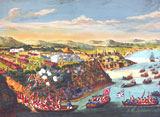|
|
|
|
|
|
|
|
|
French Mortar | French Officer's Sword British Sergeant's Sword French Infantry Musket French Bayonet French Civilian Musket British Musket British Bayonet 
French Mortar Mortar, 32.5-centimetre CWM 19430003-001
This mortar formed part of the defences of Louisbourg during the British siege
of 1758.
Made of cast iron, it could propel a 60-kilogram shell for up to four
kilometres. Exploding mortar shells could shatter ships and buildings.
Flying shell fragments could kill or wound anyone standing nearby.

French Officer's Sword
French Hanger IL 2004009-001 This sword belonged to Lieutenant Pierre Raby
of the Régiment de
Guyenne, which served at the Battle of the Plains of Abraham. Officers like
Raby often preferred short, light swords which would not become entangled in
the branches and brush of Canada's forests.

British Sergeant's Sword
Broadsword, Highland Basket-Hilted, Pattern 1740 CWM 19720103-006
Sergeant James Thompson of Fraser's Highlanders carried
this claymore
(broadsword) at the Battle of the Plains of Abraham. Scottish claymores are
deadly weapons that can inflict horrifying wounds or kill with a single blow.

French Infantry Musket
Musket, Infantry, Model 1754 CWM 20020045-449
Many French regulars at the Battle of the Plains of Abraham were armed with
Model 1754 muskets. French and British military muskets weighed about four
kilograms. A trained soldier could fire two to three shots per minute.
A well-aimed shot could hit a person at 50 metres. Armies advanced to close
range before opening fire.
French Bayonet
Socket Bayonet for Infantry Musket, Model 1754 CWM 19840363-002
Bayonets turned muskets into spears. Fastened to the muzzle end of a musket by
a locking ring, they provided soldiers with a close-combat weapon.

French Civilian Musket
CWM 19770352-002 The Canadian militia and First Peoples often brought
their hunting weapons to the battlefield.
Hunting weapons were lighter than military firearms, but more fragile. This one
weighs about three kilograms.

British Musket Long Land Musket, Pattern 1742 CWM 19920116-104 British soldiers at the Battle of the Plains of Abraham
carried Long Land Pattern Muskets.Regulars fought in close formation to
compensate for the short range and inaccuracy of their weapons. They stood
shoulder-to-shoulder and fired simultaneously. Most musket balls missed their
targets. Yet a single volley from disciplined troops could shatter an enemy
army.
|
|||||||||||||||||||||||||||||||||||||||||||||||||||||||||||||||||||||||||||||||||||||||

